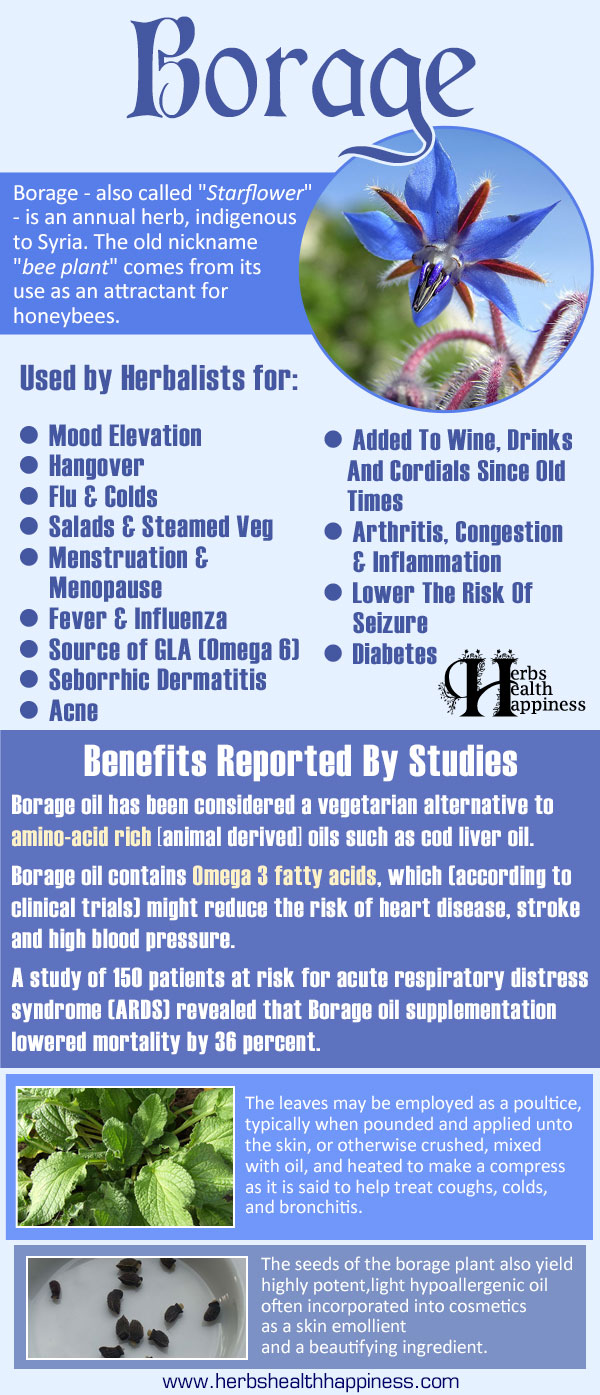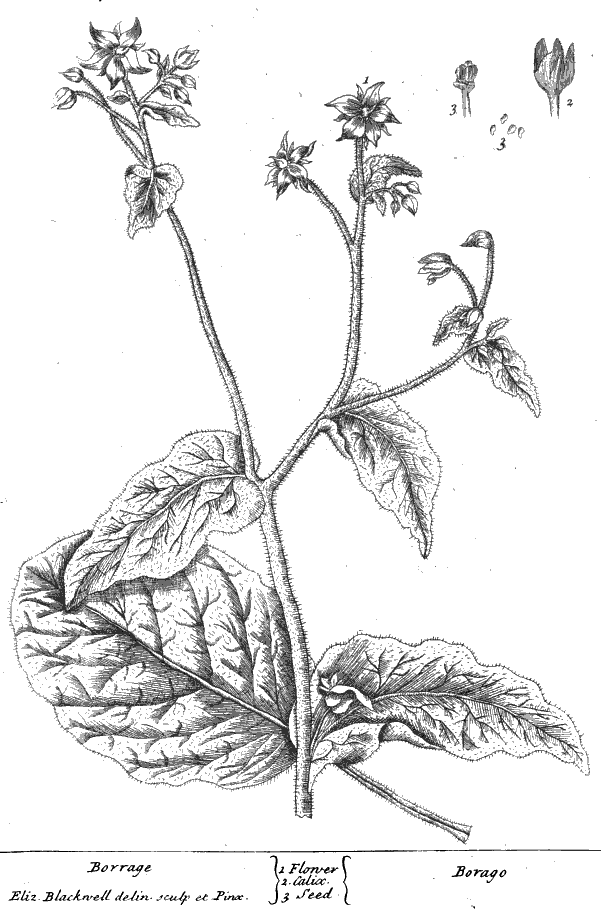Borage

Uses Of Borage - image to repin / share
Graphic - herbshealthhappiness.com. Image sources - see foot of article.

Borage - Botany And History
Borage - also called "Starflower" - is an annual herb, indigenous to Syria. Borage has been a common botanical in parts of Europe with warm climates for many centuries. Today, borage also grows in open spaces across the west coast, the north and northeastern United States. The old nickname "bee plant" comes from its use as an attractant for honeybees.[1]
Borage was for many a year one of the most commonly used medicinal plants in Europe, alongside rosemary, thyme, and mint. It has been in use medicinally since ancient times, with the earliest uses of the plant dating back to the time of Ancient Greece on to the Roman Empire, where it was thought that the plant throve in Aleppo and Damascus. This supposedly 'Mediterranean' plant is, in all actuality, a hardy shrub that thrives even in somewhat inhospitable climes, and can now be found throughout much of Europe, the Americas, and even some parts of Asia.
Despite once being considered valuable, borage is now more commonly thought of as a weed. It is characterised by its generally hairy appearance (the plant is replete with stiff, white prickles resembling tiny hairs) and its large, dark-green oval leaves. It is commonly found thriving in waste areas such as sidewalks, abandoned lots, and in untended gardens. Borage can also be grown properly in garden plots, although nowadays it is grown more for its colourful and purposeful flowers (it makes for a good source of honey), than for its medicinal uses. Still, those who try their hand at traditional herbal medicine will find that growing borage in their backyard can prove to be very useful in the long run.
Borage - Herbal Uses
Prior to the present time, borage was originally employed as both a culinary spice and as a vegetable – something quite popularly done during the early to latter parts of the 18th to 19th centuries, but that however declined with the zenith of the industrial age and the growing availability of sundry exotic spices and foodstuffs to the general masses at far cheaper prices. Borage, when employed for cuisine takes on a fresh fragrance reminiscent of cucumbers, once making it a useful addition to fresh salads and aperitifs in lieu of, or in accompaniment with cucumber. It is still used in cuisine in some parts of Europe.
The leaves and stems of borage, when steeped into any kind of liquid also gives it a vibrant, fresh taste, which made it a choice herb for the creation of cooling and soothing summer drinks in the past – a practice now forgotten by many individuals. These days, these qualities are often put to good use by masterful blenders of alcoholic drinks, as borage leaves still feature as a primary ingredient in some skillfully made homebrewed ales, or in fine wines and ciders. A little known fact is that borage leaf, when used as a mixture in acts not only as a coolant, but as a soothing relaxant or 'cordial', from which many of the sweet or pleasant liqueurs referred to as 'cordials' get their name. [1] The flowers of the plant are also edible, just like the leaves, and may be eaten raw mixed with salads, or otherwise brewed as a tisane (tea).
Borage oil - which is extracted from the seeds of the borage plant - is a potent source of GLA (gamma-linolenic acid, also called "Omega 6").[2] Borage oil has traditionally been used in the treatment of arthritis, congestion and inflammation. Borage oil has also been used as a supplement to conventional treatment in cases of diabetes. The herb is reported to alleviate symptoms of fever and influenza, as well as temporary flu-like symptoms such as the occasional hangover.[1]
Borage oil is often compared to Evening Primrose oil. Borage and Evening Primrose oils are considered emollient herbs, and both are reported to have helped in cases of arthritis. When used together, the two are considered to potentially lower the risk of seizure. However, these claims have not been verified according to modern science.[1]
When employed medicinally, the leaves (and in older pharmacopoeias, the flowers) of the plant are usually employed, either in its fresh or dried form. As is typical of most remedies, the fresh plant parts are usually decocted, with varying strengths of the decoction being taken for curing a wide variety of ailments. Aside from its leaves and flowers, the stem of the plant, which is hollow and that contains a goodly amount of mucilaginous matter, as well as its roots have also been used by ancient herbalists as a medicine. The leaves, when used fresh or dried is typically prepared as a decoction and drunk as a kind of 'natural mood booster', taken for 'melancholy' – a term once employed for depression. The leaves is also believed by traditional herbalists as a general tonic best drunk by convalescent individuals, which is supported by accounts of many ancient authors on the subject, among them Dioscorides, Linnaeus, and Pliny the Elder[3]. A reference made by Pliny suggests that Borage oil was added to wine in order to increase a person's sense of well-being.[2]
The leaves may also be employed as a poultice, typically when pounded and applied unto the skin, or otherwise crushed, mixed with oil, and heated to make a compress as it is said to help treat coughs, colds, and bronchitis. This treatment may be accompanied by tea made from the leaves and / or flowers of the plant – by itself, or combined with other herbs that possess febrifuge properties. This tea may also be drunk by nursing mothers, as it also acts as a galactagogue or breast milk increasing drink [4]. Historical documents indicate that borage was also used by traditional healers as a remedy for premenstrual, menstrual and menopausal complications.
When infused or left to macerate in oil, its flowers and leaves are considered to impart a hypoallergenic and emollient property to the oil that is helpful for treating seborrhic dermatitis, acne, and mild inflammations. The petals may even be candied by adding it into syrups made from molasses, sugar, jaggery, or honey and taken either as a sweet after-dinner snack, or as a therapeutic lozenge useful for treating the onset of colds, coughs, and sore throats [5].
The seeds of the borage plant also yield highly potent curative oil called oil of borage – a light hypoallergenic oil often incorporated into cosmetics as a skin emollient and a beautifying oil. Oil of borage helps to treat minor skin diseases such as seborrhea, dandruff, fungal infections, and eczema without drying or harming the skin. Oil of borage may even be highly diluted in jojoba oil or some other hypoallergenic oil and applied (by itself, or with other essential oils like lavender and rosemary) to treat cradle-cap [6]. When employed as an aromatherapy oil or as a massage oil, it can also help to alleviate stress, soothe rheumatic aches and pains, and aid in relaxation, while integrated in very minute amounts to drinks yields a mild narcotic that may be employed as a sleeping aid. The oil may even be vapourised by diluting a few drops of oil of borage in a cup or a tub of boiling water, after which the ensuing fragrant vapours are then inhaled. This makes for a quick home-made inhaler that aids in the decongestion of stuffy noses and the treatment of migraines brought about by colds or flu.

Borage - Scientific Studies And Research
Borage oil has been considered a vegetarian alternative to amino-acid rich [animal derived] oils such as cod liver oil. In daily doses of 500 - 720mg, Borage oil is considered to be tolerable and safe.[1] Borage oil contains Omega 3 fatty acids, which (according to clinical trials) might reduce the risk of heart disease, stroke and high blood pressure.[2]
Scientists have found that constituents of Borage include a variety of fatty acids-- 75% of which are linolenic, linoleic and oleic acids. Research on the fatty acid profile of the borage plant revealed that the seeds contain Omega-6 polyunsaturated fatty acid--a type of y-linolenic acid, which is also found in evening primrose (Oenothera biennis L.) and black currant seed (Ribes nigrum L.).[1]
In the United States, Borage oil is marketed as a dietary supplement but has not been reviewed by the FDA regarding its safety or effectiveness. Borage oil is not considered safe by Germany's Commission E because its alkaloids are thought to be potentially carcinogenic.[1]
A study of 150 patients at risk for acute respiratory distress syndrome (ARDS) revealed that Borage oil supplementation lowered mortality by 36 percent. White blood cell counts were significantly lower in patients treated with Borage oil--which researchers at the Mayo Clinic attributed to its high GLA concentration.[2]
The results of a Canadian study indicate that a daily dose of Borage oil might lower blood pressure.[2] Recent findings suggest that Borage oil might reduce the risk of stroke, but subsequent research must be performed before a definitive claim can be made.[1]
Borage - Contraindications And Safety
One report has been made of a case of status epilepticus (a serious type of seizure) associated with borage oil ingestion. [7] The abstract states that borage oil had been consumed for a week - yet without purchasing the scientific paper one cannot ascertain the dose, nor the other conditions present at the time of the symptoms. Borage has been in use for centuries and has probably been used by millions of people - leading one to observe that although appropriate caution should always be practiced using herbs, one case of sickness which may or may not have been caused by the borage is likely to constitute a small danger when compared to the statistics associated with many pharmaceutical medicines.
Borage - Esoteric / Magical Uses
In magickal practice, borage is typically placed beneath a bed to aid in astral travel, while mediaeval superstitions credit the carrying of borage leaves and blossoms as a booster for one's courage. Both its flowers and leaves when dried may be used as an incense to help cleanse oneself of negative thoughts, or to bring about forgetfulness, especially of painful or traumatic happenings – as it was once referred to as 'nepenthe' – the dread incense in Poe's 'The Raven' that was said to bring about total amnesia. A tea made of borage flowers and leaves, or a combination of borage flowers, periwinkle, rosemary, and forget-me-nots when used to wash the floor of a household was also said to bring about domestic tranquility and order in the Hoodoo magickal tradition [8], while some shamanic practices credit borage (when smoked or inhaled in incense form) as an herb that dispels ill humours and soothes the weary soul. Due to its 'soothing' property, borage is considered a great herb to use for reconciliations, and to promote peace and harmony especially if used as a blessing herb or warding herb. Medicine pouches, gris-gris, or juju bags containing borage is said to promote peacefulness and tranquility to the bearer, and is thought to attract many friends and amicable companions to the bearer's hearth or person.

Borage in old Herbals & Pharmocopœia
Elizabeth Blackwell's "A Curious Herbal" (1751): 1. It grows to be 18 inches high, the leaves are a grass green, and the flowers purple. 2. It grows frequently as a weed in Gardens; and is often found wild near houses and upon walls; and flowers in June. 3. The Leaves are esteemed cordial, comforting the heart, preventing faintness and melancholy. The tops are much used in Wine and cool-tankards. They are accounted Alexipharmic, and good in malignant Fevers. The flowers are one of the four cordial flowers. The officinal preparation is the conserve of the flowers. Matthiolus recommends the whole plant distilled as good for ye inflammations of the eyes, whether inwardly or outwardly applied.
William Thomas Fernie - "Herbal Simples" (1895): - BORAGE: The Borage, with its gallant blue flower, is cultivated in our gardens as a pot herb, and is associated in our minds with bees and claret-cup. It grows wild in abundance on open plains where the soil is favourable, and it has a long-established reputation for cheering the spirits. Botanically, it is the Borago officinalis, this title being a corruption of cor-ago, i.e., cor, the heart, ago, I stimulate - quia cordis affectibus medetur, because it cures weak conditions of the heart. An old Latin adage says: Borago ego gaudia semper ago - "I, Borage, bring always courage." This plant was the Bugloss of the older botanists, and it corresponds to Our Common Bugloss, so called from the shape and bristly surface of its leaves, which resemble bous-glossa, the tongue of an ox. Chemically, the plant Borage contains potassium and calcium combined with mineral acids. The fresh juice affords thirty per cent., and the dried herb three per cent, of nitrate of potash. The stems and leaves supply much saline mucilage, which, when boiled and cooled, likewise deposits nitre and common salt. These crystals, when ignited, will burn with a succession of small sparkling explosions, to the great delight of the schoolboy. And it is to these saline qualities the wholesome, invigorating effects and the specially refreshing properties of the Borage are supposed to be mainly due. For which reason, the plant, "when taken in sallets," as says an old Herbalist, "doth exhilarate, and make the mind glad," almost in the same way as a bracing sojourn by the seaside during an autumn holiday. The flowers possess cordial virtues which are very revivifying, and have been much commended against melancholic depression of the nervous system. Burton, in his Anatomy of Melancholy (1676), wrote with reference to the frontispiece of that book :-
"Borage and Hellebore fill two scenes,
Sovereign plants to purge the veins
Of melancholy, and cheer the heart
Of those black fumes which make it smart;
The best medicine that God e'er made
For this malady, if well assaid."
"The sprigs of Borage," wrote John Evelyn, "are of known virtue to revive the hypochondriac and cheer the hard student."
"To enliven the sad with the joy of a joke,
Give them wine with some borage put in it to soak."
According to Dioscorides and Pliny, the Borage was that famous nepenthe of Homer which Polydamas sent to Helen for a
token "of such rare virtue that when taken steep'd in wine, if wife and children, father, and mother, brother and sister, and all thy dearest friends should die before thy
face, thou could'st not grieve, or shed a tear for them." "The bowl of Helen had no other ingredient, as most criticks do conjecture, than this of borage." And it was declared
of the herb by another ancient author: Vinum potatum quo sit macerata buglossa maerorum cerebri dicunt aufeire periti: -
"To enliven the sad with the joy of a joke,
Give them wine with some borage put in it to soak."
Parkinson says, "The seed of Borage helpeth nurses to have more store of milk, for which purpose its leaves are most conducing." Its saline constituents promote activity of
the kidneys, and for this reason the plant is used in France to carry off catarrhs which are feverish. The fresh herb has a cucumber-like odour, and when compounded with lemon and sugar, added to wine and water, it makes a delicious "cool tankard," as
a summer drink. "A syrup concocted of the floures," said Gerard, "quieteth the lunatick person, and the leaves eaten raw do engender good blood." Of all nectar-loving insects,
bees alone know how to pronounce the "open sesame" of admission to the honey pots of the Borage.

Other names for Borage, Past or Present
English - Borrage, Common Borage, Bee Plant, Bee Bread, Ox's Tongue, Talewort, Starflower, Cool tankard, Common bugloss (once attributed in ancient times simply as
'bugloss', despite not being true bugloss)
Latin - Borago officinalis, Borrago, Buglossum, Nepenthe (esoteric), Euphrosinium (esoteric)
German - Burretsch
French - Borrache / bourrache commune / feuille de bourrache / fleur de bourrache / launge de boeuf / pain-des-Abeilles
Spanish - Borraja, Borrajenes, Borrajes
Dutch - Bernaasje
Portuguese - Burage, Burrage
Italian - Borragine
Borage Illustration:

Borage
Infographic Image Sources:
https://commons.wikimedia.org/wiki/File:Starflower_1.jpg
https://commons.wikimedia.org/wiki/File:Borago_officinalis.Borretsch_Samen.JPG
https://commons.wikimedia.org/wiki/File:Borago_officinalis_in_late_september_2009.JPG
https://pixabay.com/en/physiotherapy-massage-back-567021/
References:
[1] Barceloux, Donald G. Medicinal Toxicology of Natural Substances: Food, Fungi and Medicinal Herbs, Plants and Venomous Animals. 2008.
John Wiley and Sons.
[2] Greenwood-Robinson, Maggie. Good Fat vs. Bad Fat. 2002. Penguin.
[3] https://botanical.com/botanical/mgmh/b/borage66.html
[4] https://www.webmd.com/vitamins-supplements/ingredientmono-596-BORAGE.aspx?activeIngredientId=596&activeIngredientName=BORAGE
[5] https://en.wikipedia.org/wiki/Borage_seed_oil
[6] https://www.shikai.com/publications/borageSkin.htm
[7] https://www.ncbi.nlm.nih.gov/pubmed/21387119
[8] https://gypsymagicspells.blogspot.com/2011/05/borage-magick.html
Main article researched and created by Kelsey Wambold / Alexander Leonhardt,
© herbshealthhappiness.com


1. Famous Chef Sheds 60lbs Researching New Paleo Recipes: Get The Cookbook FREE Here
2. #1 muscle that eliminates joint and back pain, anxiety and looking fat
3. Drink THIS first thing in the morning (3 major benefits)
4. [PROOF] Reverse Diabetes with a "Pancreas Jumpstart"
5. Why Some People LOOK Fat that Aren't
6. Amazing Secret Techniques To Protect Your Home From Thieves, Looters And Thugs
7. The #1 WORST food that CAUSES Faster Aging (beware -- Are you eating this?)
If you enjoyed this page:





























